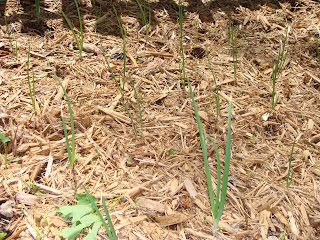When we first purchased our home, I envisioned the possibility of a sunny backyard garden brimming with a cornucopia of fresh vegetables. It would always be beautiful to look at and provide any desired vegetable at any given time of year---sort of like the produce department at the grocery store, only closer! More about this misconception later....
The first new home task my husband and I set out to do was clear out the 400SF raised garden plot that the previous owner had let go au naturale. And when I say clear out, I mean the equivalent of taking a
machete, wearing battle armour and blindly swinging. We had everything from a
miniature pine tree to head-high thorn bushes to the dreaded invasive mint growing. Worst of all, we seemed to have about 13 plants of what looked to be "elephant ears" with root systems anchored in the center of the earth. Those large leafed pesky weeds!
"Yeah", said our new neighbor, "how much rhubarb can one family eat?".
Rhubarb?!
I rationalized that even if it was a
real vegetable that theoretically
belonged in a kitchen garden, it didn't matter that we yanked it all out and
whisked it into the trash heap. I don't know how to cook rhubarb anyway. And the only recipe I'd ever heard of using it was strawberry rhubarb pie. My husband is allergic to berries, and I don't "do" pie crust. So it's all good.
My heart sighs when I
reminisce back 4 years ago when we dismembered all that rhubarb. Since then, I've developed an obsession of cooking with fresh, seasonal ingredients. Rhubarb has become a spring staple in our house, but alas, I have no rhubarb plant to call my own and am at the mercy of 2 lowly plants belonging to my generous, 90+ year old neighbor for my annual supply.
For those totally unfamiliar with rhubarb:
1. Don't eat the leaves. They're poisonious.
2. You don't have to peel the rhubarb when using it in a recipe.
3. Click on this link to learn how and when to
harvest rhubarb.
And if you think your kids won't eat it, try this:
Whole Wheat Rhubarb Cake(modified version of Rhubarb Cake I by Barb Oke on Allrecipes.com)Ingredients1/2 cup butter
1 1/2 cups white sugar (I'm tempted to try honey, but I haven't yet)
1 egg
1 teaspoon vanilla extract
1 cup all-purpose flour
1 cup whole wheat pastry flour
1 teaspoon baking soda
1/4 teaspoon salt
1 cup buttermilk
2 cups rhubarb, chopped
1 tablespoon whole wheat pastry flour
1/4 cup butter, softened
2 teaspoons ground cinnamon
1 cup packed brown sugar (Maybe try sucanat?)
Directions1. In a large bowl, cream butter and sugar together. Beat in egg and vanilla.
2. In another bowl, whisk the flours, baking soda, and salt.
3. Add dry ingredients alternately with buttermilk to creamed mixture.
4. Toss rhubarb with 1 tablespoon whole wheat pastry flour and stir into batter.
5. Pour batter into buttered 9 x 13 inch pan.
6. Make the topping by blending together 1/4 cup softened butter, cinnamon, and brown sugar, then sprinkle on top.
7. Bake at 350 degrees F for 45 minutes.
Now I need your help. I challenge you to modify this recipe to increase the number of local ingredients and/or nutritional value.
 So I know you've been dying to see my backyard garden. Here it is behind the white fence. Enter the gate, and this is what you see.
So I know you've been dying to see my backyard garden. Here it is behind the white fence. Enter the gate, and this is what you see.










